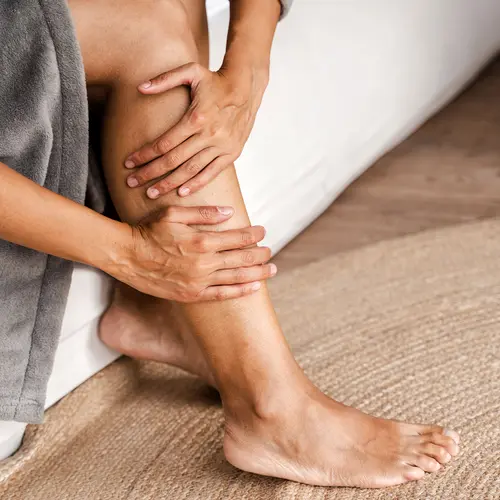We’ve all had leg pain at some point. Maybe you banged your shin against your favorite chair, or you had an intense cramp in your thigh or calf muscle. It hurt, but it got better fast.
Leg pain that seems severe, ongoing, or out of the ordinary is a different story. Sometimes it’s a sign of an urgent problem that could stick around -- or get worse -- without treatment.
Call your doctor if you have one of these types of leg pain.
Painful, Swollen, and Warm
If your lower leg or thigh feels this way, it could be due to a blood clot called deep vein thrombosis (DVT). Skin in the area may also be sensitive to touch and reddish in color. Sometimes a DVT has no symptoms.
Things that can make you more likely to get a deep-vein clot include if you:
- Have had DVT before
- Are pregnant
- Have had prolonged bed rest
- Are older than 65
- Have had major surgery
- Use birth control or hormone replacement therapy
- Have certain cancers
- Are taking certain cancer treatments
A DVT blood clot is dangerous because it can break loose, travel to your lungs, and get caught in an artery there. When that happens, it's called a pulmonary embolism (PE).
You could have symptoms like:
- Chest pain
- Trouble breathing
- A cough that may bring up blood
A PE is an emergency, and it can be deadly without treatment.
Ongoing Leg Cramps and Fatigue
If you have these in your calf or thigh while walking -- and they get better with rest -- you might have peripheral artery disease (PAD). That’s when plaque gradually builds up in the arteries that carry blood to your limbs. PAD usually affects your legs. It prevents them from getting enough blood.
You’re more likely to get PAD if you:
- Are 65 or older
- Smoke
- Are obese
- Have high cholesterol, high blood pressure, diabetes, or kidney failure
Without treatment, there’s a chance that PAD could eventually bring on problems like:
- Sores
- Serious infections
- Pain while you’re not moving
It could even lead to gangrene. That's dying tissue that sometimes leads to amputation.
‘Electrical’ or Burning Pain
When pain like this starts in your lower back or hip and runs down the back of one leg, it may be due to a condition called sciatica. You might feel:
- More pain when you move, sneeze, or cough
- A bad, long-lasting leg cramp
- Weakness or tingling in your leg
- “Pins and needles” sensation
Your sciatic nerve is the longest and widest nerve in your body. It branches from your lower back down into your legs. If it gets pinched due to a herniated disk in your spine or something else, that can bring on the symptoms of sciatica, usually in only one of your legs.
Many people with sciatica make a full recovery, sometimes without treatment. But you still need to see your doctor if you have sciatica symptoms, because without treatment, it’s possible to have complications like:
- Loss of feeling in your leg
- Bowel or bladder problems
- Permanent nerve damage
Sudden Sharp Pain
It could be due to one of these serious injuries. See your doctor to make sure your leg heals properly.
Achilles tendon tear. Your Achilles is a tough band of tissue that connects your calf muscle to your heel bone. You use it when you walk, run, and jump. If you tear it partly or completely, you might feel sudden pain in the back of your leg above your heel. You may also hear a popping sound when it happens. Afterward, you could have a hard time putting weight on your foot or walking normally.
Many people tear their Achilles while playing a sport that involves jumping or abrupt starts and stops. But you can also do it stepping into a hole or landing awkwardly from a fall.
ACL tear. Your anterior cruciate ligament (ACL) is a short, diagonal band of tissue that helps hold your knee joint together and helps it remain stable. If you tear it partially or completely, you might hear a popping sound along with the pain. Your knee may give out on you and become unstable or wobbly. Hours later, it could swell.
Some things that can raise your risk for an ACL injury are:
- Sports with sudden stops and direction changes
- Firmly planting your foot
- Slowing down while you run
- Getting hit or tackled in the knee
Hamstring tear. A group of three muscles run along the back of your thigh. They’re called the hamstrings. If you tear one of them, or tear a tendon in the back of your thigh, it can bring on sharp pain. The area may get swollen within a few hours, and the back of your leg below your knee may look bruised or discolored in the days ahead.
Hamstring tears tend to happen while you’re:
- Running
- Dancing
- Playing sports with lots of stop-and-start motions
Teenage athletes who are still growing have higher odds of getting this injury.

